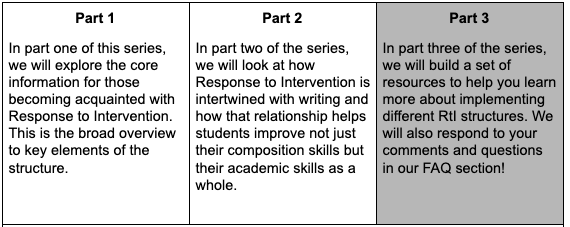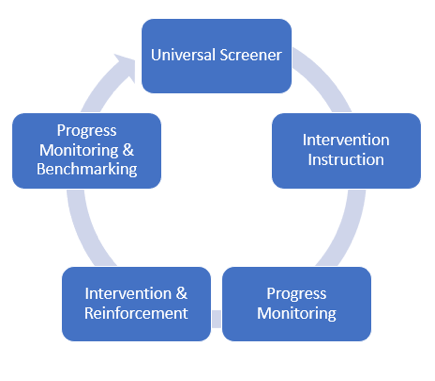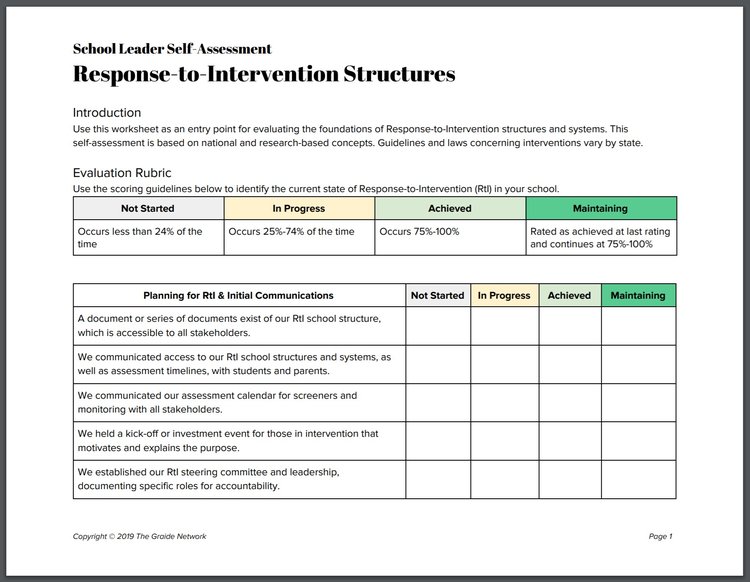Response to Intervention works. This process, now integrated into the most recent revision of the Every Student Succeeds Act, is proven to move a school organization into a growth state. Through RtI’s structure and systems, students get the support they need, when they need it, and most importantly, before it may be too late.
If RtI is implemented across all grades with fidelity, then each year should end with all students near, on, or above grade level. Those who remained unresponsive to instruction and intervention now receive more specialized services.
If we know this and the data shows this, why aren’t all schools jumping on board to implement a high-functioning RtI for their students?
“Why aren’t all schools jumping on board to implement a high-functioning RtI for their students?”
The list of possible concerns is long, but most of them are rooted in larger issues:
- We don’t know what RtI is and how to implement it.
- We don’t have the resources to implement this system.
- We’ve implemented our RtI but aren’t seeing results.
Let’s focus our time on examining the second issue which often gets in the way: resources.
There are many programs that claim to provide RtI and Tiered Intervention services but might not actually produce the necessary results for your writers. For example, how are you supposed to know when you need to purchase full-blown programs when you really only need the assessments?
We’re here to help you navigate the process of locating which programs and resources you really need to provide your RtI staff in the creation and implementation process.
About this Series

At the end of the series, you will be able to answer the following big questions:
- What are the basics of Response to Intervention (RtI)?
- How do Response to Intervention and writing live together in my school?
- What do I need to implement a high-quality Writing RtI?
What Do I Need for Writing RtI?
There are many programs and documents to prepare when implementing a high-functioning RtI. While some of the documents and programs are used for all tiers (attendance tracking, data spreadsheets for graphing, etc.), others are specific to the subject of intervention. Math will have its own program or set of programs, and the same is true of reading and writing, so it’s important to determine the basic resources needed to begin RtI for writing.
You will need:
(1) Universal Screener
(2) Progress Monitoring CBM
(3) Benchmarking Assessments
(4) Graphing and Reporting
UNIVERSAL SCREENERS: HOW DO WE FIND AT-RISK WRITERS?
A teacher’s intuition is usually accurate. We spend hours upon hours working with kids, and we know the nuances that make each student’s writing unique.
RtI asks us to go one step further in education and prove what we believe. That is where Universal Screeners come into play.
This is where things get interesting. I’ve taught in South Carolina, Pennsylvania, and Tennessee, and I’ve worked with a few nationwide education platforms. As an educator and a leader, I’ve often claimed that my students were good writers. That statement is almost meaningless. Are my students good writers… for our city? Are my students good writers for our state? Are my students good writers for our region? Are my students good writers for our nation?
Our economy is a global economy, which means that my writers need to be on the same level (or above) other students of the same age across the nation– and ideally across the world. One problem: I haven’t seen, analyzed, or evaluated student writing at the volume and diversity that I would need to in order to know they are on the same level. I rely on research-backed data collected from nationally administered Universal Screeners.
It is imperative that the Universal Screener is an external measure, meaning that it comes from peer-reviewed and published means as much as possible. It can be tempting to try to skimp and create internal means of assessment, but I want to warn against this decision.
Internal measures of assessment do not go through the same rigor of development as the Universal Screener; they therefore lack a true administration that returns results that can be trusted without a doubt.

Before we continue, let’s refresh our purpose.
Much like the healthcare system discussed in the first post, we cannot provide targeted, specific, and purposeful intervention to the entire population. We need to identify those who need it most through screening. Screening must effectively create a list of students who need the additional intensity in intervention before it is too late. Screening is the most important step in the RtI process.
Without a high-quality screener, too many results, too few results, or inaccurate results will misdirect the school’s RtI structure and reduce any expected acceleration.
While reading and math RtI use programs such as NWEA Map to screen those slightly or significantly behind grade level, writing lacks any one frontrunner to screen students. According to these companies, there are many reasons for the lack of widespread writing screeners: too many variables in writing, lack of expedited grading, and deprioritizing writing supports over reading supports.
With so few programs on the market, how are leaders supposed to determine what resources to provide their teachers?
The basics of a Universal Screener are not specific to a state or region:
- Research-based
- Evidence-based
- Normed across district, state, and nation to determine percentiles
- Given to entire age range or grade level
- Assesses standard and skills to determine grade level gap
- Has adaptive questioning up and down to identify current grade level mastery range

The frequency of the Universal Screener is important to decide in the summer prior to the start of the school year. Generally, screeners are given within the first weeks of school and then again in the middle of the year. The school year should end with administration of the screener.
Here are some important points for school leaders to keep in mind:
- The initial Fall administration indicates any loss of knowledge and skill over the previous two months and provides the initial tiers of students. These results also provide growth lines from student scores. The school now knows targets for individuals and grade levels. These can be used as motivation to unify school staff to accelerate the students.
- The Winter administration not only provides updated tiers of students for intervention but also data relevant to the effectiveness of Tier I instruction. Teachers and leaders can now look to see how instruction in all classrooms is reaching the students in the school. Are students responding to teachers’ instruction in our school by indicating they are growing at a rate relative to local, state, and national norms? If students remain stagnant or decline, more emphasis should be put on studying and redesigning instruction in all classrooms.
- The Spring administration determines how effective the school is in growing students in those areas within one year of instruction. If goals and targets are met, the achievement gap closes. However, if there are more misses than successes, this data should drive administration in determining what changes are needed in the following year to improve the quality of instruction in the school.
Universal Screeners are often packaged with Curriculum-Based Measurements (CBMS) used for Progress Monitoring in Tier II and III. Before we look at individual writing programs, we’ll review Progress Monitoring tools and needs of a program for Writing RtI.

Progress Monitoring: How Do We Know It’s Working?
The Universal Screener was given, and you have established your tiered grouping of students. Before intervention starts, leaders and teams must create their calendar and systematize monitoring the progress of students in each tier. Educators need to feel prepared to implement quick, reliable formative assessments to drive their interventions.
Progress Monitoring refers to the act of giving a formative assessment at routine intervals using, ideally, an external and normed method of collection. These are often referred to as Progress Monitoring Probes or Curriculum-Based Measurements (CBMs).
Probes are quick, timed assessments that are externally created and given every two weeks for Tier II and every week for Tier III. CBMs are similar to Probes except they are created internally or by contracting an qualified educator. CBMs measure the same standards or skills as Probes but use the child’s curriculum as their foundation. There are benefits and drawbacks to each of these paths in obtaining formative data on student responsiveness to your school’s intervention programs.
Probes and CBMS share basic principles:
- Timed administration, usually 1-5 minutes in length
- May be scored for speed, fluency, or accuracy
- Target grade level skills in Tier II and transferrable, foundational readiness skills
- Results determined almost immediately
- Results charted and graphed to determine growth

As with Universal Screeners, Progress Monitoring Tools have a specific purpose. Educators are determining if students are responding to the intervention instruction.
This data should indicate that the student is closing their individual achievement gap with that standard or foundational skill by continuing in an upward trend toward their end goal. This means they are responding to the program and teacher in the room for their intervention. Likewise, a student whose data falls below the goal line indicates they are not responding to the program and teacher in the room.
Purchasing Writing RtI Resources: What’s Worth it?
With all of the requirements, one would hope that the market is full of good options with a few standing out as clearly providing great assessment services for Writing RtI. Unfortunately, a quick Google search for Writing RtI actually leads to more Teachers Pay Teachers resources than validated programs.
Let’s take a look at some of the programs that claim to help Response to Writing Intervention:
- Easy-CBM
- DeCoste Writing
- aimsWeb
- ANet
- WritetoLearn
- TOWE
- wrAP
- Functional Writing
Easy-CBM is a great tool for storing and representing progress monitoring data. Individual teachers can create free accounts to use in RtI and general education classrooms. Let’s see where it fits in!
A teacher gives their CBM for Progress Monitoring and takes that data point to enter into their Easy-CBM account, which will then help the teacher generate a spreadsheet and graph as per compliance requirements. This site is widely popular amongst interventionist and special educators, particularly in documenting literacy, numeracy, and behavioral interventions.
Easy-CBM does not offer writing CBMs. While there are plenty of great CBMs for literacy and numeracy for Tier III interventions, there are no provided CBMs for any tier of writing RtI. The company offers two reasons for the lack of CBMs in writing: (1) “The most genuine writing measures depend on human ability to evaluate writing quality…” (2) “…opinions on ‘quality’ can vary quite a bit depending on the person doing the evaluating.”
Yes! It is true without a doubt that the quality of the human scorer is the main factor in the quality of the results in writing assessments. Efficient and effective RtI writing programs require valid and reliable data. How are teachers going to specialize in all of the intricacies of writing evaluations when their plate is filled with a main course of lesson planning, a side of social-emotional learning, another side of grading, and a dessert of contacting parents.
Marco Learning solves this issue for schools. Marco Learning provides schools with high-quality, remote teaching assistants, called Graders. who help score and provide feedback on student writing. Learn more about how it works here.
For schools looking to improve their data warehousing of RtI data, easy-CBM may be the way to go; however, you will still need to purchase or create reliable and valid CBMs.

The DeCoste Writing Protocol from Don Johnston Learning Tools provides a formative assessment tool specific to writing. These assessment tools are highly specific to the foundations of writing in both handwriting and typing. As stated on their website, the Writing Protocol works to identify factors impacting one’s ability to produce writing. The key word here is identify.
While the assessments are formative, their focus is more about identification of elements more appropriate for the Tier II to Tier III or Tier III to Tier IV (Special Education) transition.
These would function less as Progress Monitoring for Tier II skills or even perhaps accurate monitoring within Tier III. If you are a school leader or interventionist looking to get to the root of students significantly behind in writing, this program may be worth your time to improve results.
aimsWeb is another program that can be used in many areas of a school. Most often, behavior interventionists and special educators are already aware of or using this program. Pearson’s assessment suite is built specifically for Universal Screening and Progress Monitoring; however, writing interventionists will be left wanting more.
While there are high-quality reading, mathematics, and behavior services provided in aimsWeb, there are no writing assessments provided for monitoring. Pearson claims, “The result is that in a single class period, teachers can get comprehensive and accurate information about student and classroom performance in reading and mathematics, and identify students at risk for dyslexia or behavior issues.”
Much like easy-CBM, a school could purchase and provide this service to its teachers as a data warehouse for charts and graphs for writing intervention, but the school would still need to purchase or create its own reliable and valid assessment means.
The Achievement Network, commonly known as ANet, provides numerous services of assessments, data review, and coaching for all levels of the school organization. ANet is used in many schools to accelerate change and increase alignment.
ANet is structured and backed as a Tier I service for its schools; however, it is not backed to be RtI assessments, progress monitoring, or other intervention services.
ANet’s services are high-quality and their assessments with detailed data and other post-assessment services can drive change in Tier I courses. ANet even offers ready-made writing assessments which are still scored by the teacher.
This leaves open the door of bias and unreliable results from overworked educators. The assessments’ design and the data following its administration do not align with those of Universal Screeners and Progress Monitoring.
ANet may bring growth to general classes and courses; however there is no specific tie to how it will impact Tier II or Tier III students. Additionally, the program hasn’t been assessed as a way to identify students who need more interventions and services.

Pearson has another writing product that some have considered for Response to Intervention. WriteToLearn provides a digital tool to implement in schools with a focus on summarizing, building arguments, and responding to source documents. The program uses advanced algorithms to assess students’ writings digitally.
Pearson states, “As students participate in assigned activities, they receive personalized feedback, hints, and tips to encourage, instruct, and reward their progress.”
While providing assistance to teachers in reaching more students and funneling the highest needs issues to the teacher, it still misses out on going beyond Tier I services.
The program does not allow for individually targeting embedded skills in a standard or specifying interventions. Results provided from Pearson do suggest it impacts overall student writing performance, which would back its use as a Tier I writing program.
Implementing this service in all ELA or English classrooms could be a factor in balancing the percentage of students that should be in each tier.
As part of the IEP identification process, educators require assessments which pinpoint the specific gaps and needs of the individual learner.
TOWE, Test of Written Expression, is a paper assessment given to those at-risk in Tier III. These students will have results on Universal Screeners that show they are unresponsive to interventions in all tiers of RtI.
These writing prompts and normed scoring results provide targeted identification of students’ gaps to create goals and learning plans for those needing special education services. Because of this limited scope, schools would be unwise to implement it as a Universal Screener or Progress Monitoring tool.
Functional Writing
CASAS Functional Writing Assessment was originally designed as a “premier system for assessing the writing skills of adults, whether they are enrolled in education and training programs or are already on the job.” It is a paper and pencil test which must be scored manually by the facilitator of the assessment.
This test is administered through the use of images and pictures as a stimulus for writing. The intended purpose of the assessment is what makes it unique: “innovative balance between life skills and workplace-focused writing.”
In its description it also meets all parts of Universal Screeners and Progress Monitoring tools. This process implements all of the research-based practices but specifically for working adults who need to elevate their writing.
While the practices are all present, it would not be acceptable to implement this program for K-12 students. Could you use it? Yes. Should you use it? Probably not.

ERB, Electronics Records Bureau, is a membership-only organization that provides diverse assessments, like the wrAP, with norms-based results. The not-for-profit organization uses pooled data to provide each school leader a glimpse into how students are progressing locally, nationally, and globally. Becoming a member is less like ordering a a test from a company and more like engaging in a partnership of better assessment practices and resources with other schools.
ERB’s wrAP assessment “is a direct measure of student writing achievement and serves as a tool to help classroom teachers pinpoint specific strengths and weaknesses of their students’ written expression.” With this description, we can think of it in terms of a Universal Screener.
Additionally, the assessments can only be given during two windows for Fall and Spring. This would provide a beginning of year and end of year data screening for at-risk students; however, you would be unable to give it at a frequency necessary for Progress Monitoring.
This assessment provides a stimulus twice a year on paper and online for all three main genres for all grade levels. ERB employs human graders who use a 6-point rubric to evaluate the writing in a standardized form. This collects and pools data across all the schools to provide normed results.
Assessments can be stimulus-based or non-stimulus based; the schools determine which to give to their students. The main difference is that stimulus-based requires reading or work prior to the writing, whereas the non-stimulus prompts students to get started with planning and writing. Results are provided through comments on the student’s writing, individual student work, and group reports.
Driven by the results, teachers can access the WRIIT Library provided by ERB. This library provides Learning Progressions, Anchor Sets, and more!
Closing
As you can probably see, schools currently lack access to a variety of high quality writing programs to choose from. The choices are often limited to programs that are not intended to be used in RtI assessments or programs that only serve as a data warehouse.
Some of the options above could be implemented but would provide inaccurate or misguided results to RtI implementation teams. One thing is for sure: schools need more high-quality RtI assessments and writing interventions to accelerate learning and close gaps in achievement.
Writing RtI FAQ: You Asked, We Answered
Implementing RtI is a team process. With any system of this size, it takes the community to ask questions early and often. From discussions with some of you and the questions you submitted to our form, we compiled a list of Frequently Asked Questions.
- How do I remove bias, subjectivity, and inconsistency from the evaluation of writing assessments?
- It is imperative to have reliable and valid data. Without sound evaluation of writing school-wide, staff are left with scores that indicate how they feel students are doing, not how students are actually doing. This could skew the need (or lack thereof) for RtI as well as cause the misplacement of students into tiers.
- Tip: Use a grading service, such as Marco Learning, to provide objective data and feedback, fueling a fire of improvement to Tier I effectiveness and the foundation for RtI.
- How do I schedule RtI into the day?
- You want to organize your schedule so that instructional time is a top priority. Begin by looking at the resources your currently have (who and what). Stay flexible and know that change can be a good thing. Start by creating a master schedule that includes your core instructional time across grade levels. Add intervention blocks to each grade level based on the required amount of time and resources available in your school. If you prioritize intervention, it will benefit all classes.
- Start by scheduling your Tier II and Tier III for Writing, Reading, and Math. Make sure the best, most skilled teachers are providing intervention services to these students. Next, build Tier I courses with the remaining staff and determine what you want the remaining students to do during that time. Some schools use the time as culture and relationship building, while others use it to provide tutoring or academic services.
- Tip: Don’t schedule RtI first thing in the morning. Attendance could impact its ability to help students, and they might not be awake enough to engage in intervention services.
- Most of our school falls into Tier II and Tier III. What does this mean and what do I do?
- If the majority of students are falling within Tier II and Tier III, you may want to check your Tier I interventions and the quality of whole group instruction. Are students’ needs being met during daily instruction and are small group lessons within the class targeting the appropriate gaps of students? Don’t let this hinder you from starting or maintaining an RtI program. It is okay–many schools find that they are in the same place when they first dig into RtI services. Next, prioritize student percentages and individual or small group organization of RtI. Tier III should allow for 1:1 instruction to that block of time while Tier II should allow for small group instruction. Avoid packing every student below the cut line into Tier II and Tier III; instead, make your roster selection systematic and objective. Remember, this runs all year so kids will have other chances to move into RtI and will still receive Tier I intervention in their classes.
- We’re a small school and don’t have the funds to purchase all these programs for all the different RtI paths and tiers. How do we still remain compliant and serve these students?
- There are a lot of high quality research based programs that are available for free. Also, look for programs that offer grants. Again, getting creative and thinking outside the box can eliminate the costs. For example, you do not need to employ an interventionist if you have highly qualified teachers. Rearranging schedules and students can free up the time of a general education teacher to provide interventions to other students outside of her own classroom of students.
- Use the links below to find readily-available Writing Interventions:
“5. We instituted an RtI structure but aren’t seeing any results. What do we need to do to improve our acceleration?”
- First, remind yourself that RtI may take some time to yield results as you tinker with
 programs and systems, as well as build the culture needed for RtI.
programs and systems, as well as build the culture needed for RtI. - Next, create a rubric, or download and use the provided Self-Assessment Worksheet here, to assess your systems and structures. See if there is anything missing in your RtI system.
- Finally, utilize a fidelity checklist to conduct walkthroughs of the classrooms and programs. Help coach teachers toward the RtI structure your team envisioned.
DOWNLOAD SELF-ASSESSMENT WORKSHEET
- What do I do with all of the data we are collecting?
- The data is collected to make informed decisions about each student in the RtI process. Progress monitoring data is used to inform instruction and ensure that student needs are being met and that progress towards their goals are being made. Universal screening data is used to decide which students may need additional support from intervention time. Remember, universal screeners are only one point of data and should not be the be all end all in deciding which students need interventions. This data needs to be maintained while the student cohort is in your school.
- Tip: Condense all of the different programs into a data dashboard where you track student data on a weekly basis. This will also make generating charts for the individual students, grade, and school to determine program effectiveness much easier.
- Who makes decisions based on students? What is the process for decision making?
- The RtI team should make decisions about a student. The exact members may differ from school to school but typically include the following:
- An administrator
- the RtI interventionist
- the general education teacher
- the literacy or reading specialist for reading intervention students
- a school psychologist and/or guidance counselor
- a speech language pathologist as needed
As a team, members should decide who will receive interventions, the movement of students between tiers, and the identification of students who may need special education services. Be sure to have established procedures and norms for data sharing and decision making. Include all decision making in writing with signatures. Many districts already have documents that schools must use in place when making decisions. Check with your district or state to see which documents you may need to record decisions made during data meetings.
- We think a student has a writing disability/exceptionality. Can we just give them an IEP?
- If there is reasonable evidence that a student has a disability, you should follow your district’s policy for referring the child for special education services; however, we cannot just assume a student has a disability because they have poor writing. The RtI process is partially implemented to determine if the student has a disability or if they just need additional interventions and supports. Placing a student into RtI will help to clarify the root of the student’s needs.
- Tip: SLD or Specific Learning Disability for an IEP may require a student to progress through RtI in some states. These are normally students who are classified with a reading, writing, or math disability in the majority of staff.
- We already do Writer’s Workshop in our blocked ELA classes. Do we still need RtI?
- Yes, a Writer’s Workshop is a great tool for improving the writing of students, however it is not a targeted intervention unless it is in a separate structure. Now, you could use the block schedule if students leave the room and go to different locations for the required time according to their specific need. If they stay in the room and all levels are together, it acts as a Tier I intervention but not Tier II or Tier III.
For more on Response to Intervention:
Underrated and Vital: RtI Writing

Brenton DeFlitch, M.Ed & EdS served as a Regional Content Coach for Secondary Education Literacy Interventions in Middle Tennessee. Throughout his 13 year career, he has designed school systems and structures for Reading and Writing RtI in both Tennessee and Pennsylvania. As a previous school leader, he oversaw RtI implementation in middle and high schools, conducted fidelity checks, and trained fellow leaders in running intervention systems.



